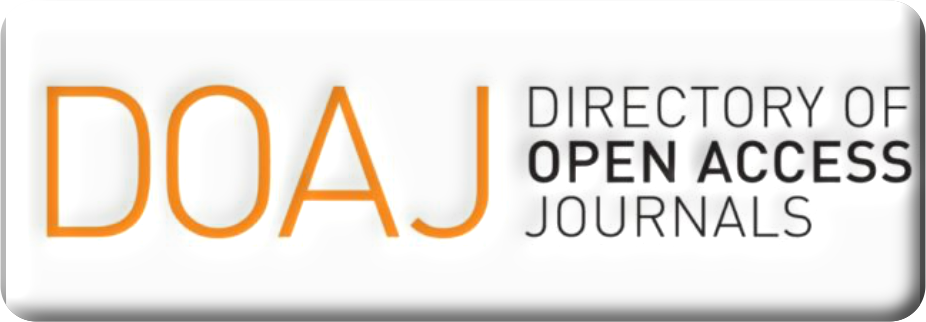Identification of groundwater potential based on geoelectrical resistivity method and hydrogeological survey (Case study of Sumber Waluh Hamlet, Pringgodani Village, Bantur District, Malang Regency)
Abstract
Bantur District in Malang Regency is an area that is vulnerable to drought disasters. A geoelectrical resistivity survey has been conducted in Sumber Waluh Hamlet, Pringgodani Village, Bantur District, Malang Regency as an effort to mitigate drought disasters. This study aims to identify the distribution of aquifer layers based on the results of subsurface resistivity modeling. The identified aquifer layers can be used as a solution to the problem of drought disasters. In this study, geoelectrical resistivity measurements used the VES technique, i.e. the Schlumberger configuration, which was carried out at seven points. Analysis of the modeling results showed the existence of a shallow aquifer layer with a depth of 8-20 meters and a deep aquifer with a depth range of 50-70 meters. The aquifer layer has a resistivity value between 0.51-31.36 Ωm which is interpreted as a tuffaceous sandstone layer. In hydrogeological modeling, it is interpreted that the position of the groundwater level is at a depth of 40-50 meters. Thus, the results of this study can be used as a recommendation for drilling points to find new water sources in the research area.
Keywords
Full Text:
PDF (01-15)References
Abd El-Dayem, M., Abd El-Gawad, A., Bedair, S., & Farag, K. S. (2023). Groundwater resource evaluation using geoelectrical resistivity survey in the Ghard El-Hunishat area of New Delta project province, North Western Desert, Egypt. Groundwater for Sustainable Development, 21, 100918.
Abdulkhaev, Z., Madraximov, M., Akramov, A., & Arifjanov, A. (2023). Groundwater flow modeling in urban areas. AIP Conference Proceedings, 2789, 040084.
Bhatnagar, S., Taloor, A. K., Roy, S., & Bhattacharya, P. (2022). Delineation of aquifers favorable for groundwater development using Schlumberger configuration resistivity survey techniques in Rajouri district of Jammu and Kashmir, India. Groundwater for Sustainable Development, 17, 100764.
Boimau, Y., & Susilo, A. (2018). Identification of Underground River Flow in Karst Area of Sumber Bening-Malang, Indonesia Based on Geoelectrical Self-Potential and Resistivity Data. International Journal of Applied Physics, 5(3), 1-7.
BPBD Kabupaten Malang. (2015). Data Kejadian Bencana Kabupaten Malang Tahun 2015. Malang: BPBD Kabupaten Malang.
BPBD Kabupaten Malang. (2019). Peta Multi Rawan Bencana Kabupaten Malang. Malang: BPBD Kabupaten Malang.
BPS Kabupaten Malang (2022). Kecamatan Bantur dalam Angka. Malang: BPS Kabupaten Malang.
Chaminé, H. I., Carvalho, J. M., Teixeira, J., & Freitas, L. (2015). Role of hydrogeological mapping in groundwater practice: back to basics. European Geologist Journal, 40, 34-42.
Ferhat, A., Seizarsyah, T., Bimantio, M. P., Nugraha, N. S., Putra, D. P., Suparyanto, T., ... & Pardamean, B. (2022, February). A geoelectric approach for karst groundwater analysis. IOP Conference Series: Earth and Environmental Science, 998(1), 012012.
Galazoulas, E. C., Mertzanides, Y. C., Petalas, C. P., & Kargiotis, E. K. (2015). Large scale electrical resistivity tomography survey correlated to hydrogeological data for mapping groundwater salinization: a case study from a multilayered coastal aquifer in Rhodope, Northeastern Greece. Environmental processes, 2, 19-35.
Haggerty, R., Sun, J., Yu, H., & Li, Y. (2023). Application of machine learning in groundwater quality modeling-A comprehensive review. Water Research, 233, 119745.
Hasan, M. F. R., Azhari, A. P., & Agung, P. A. M. (2021). Investigasi Sumber Air Tanah Menggunakan Metode Geolistrik Resistivitas Konfigurasi Schlumberger dan Pengeboran. Jukung (Jurnal Teknik Lingkungan), 7(2).
Hasan, M. F. R., Fransiska, C. D., Suaidi, D. A., Wisodo, H., Martina, N., & Rahmat, A. (2021). Identification of seawater intrusion using geoelectrical resistivity method in the Goa Cina Beach Malang Area, Indonesia. IOP Conference Series: Earth and Environmental Science, 739(1), 012002.
Hasan, M. F. R., & Susilo, A. Sunaryo. (2018). Identification of Underground River Flow Pattern Using Self Potential (SP) and Resistivity Methods for Drought Mitigation at Druju, Sumbermanjing Wetan, Indonesia. Disaster Advances, 11(5), 25-31.
Juwono, A. M., Susilo, A., Hasan, M. F. R., Yunika, N. A., Annabil, A. A., Mujtaba, M. W. H., & Haniyyah, S. (2024). Investigation of Groundwater Sources in Banyol Hamlet Malang Regency Using The Geoelectrical Resistivity Method to Overcome Drought Strategy. Indonesian Physical Review, 7(2), 240-248.
Koch, K., Wenninger, J., Uhlenbrook, S., & Bonell, M. (2009). Joint interpretation of hydrological and geophysical data: electrical resistivity tomography results from a process hydrological research site in the Black Forest Mountains, Germany. Hydrological Processes: An International Journal, 23(10), 1501-1513.
Lubang, J., Liu, H., & Chen, R. (2023). Combined application of hydrogeological and geoelectrical study in groundwater exploration in Karst-Granite areas, Jiangxi Province. Water, 15(5), 865.
Mahmud, S., Hamza, S., Irfan, M., Huda, S. N. U., Burke, F., & Qadir, A. (2022). Investigation of groundwater resources using electrical resistivity sounding and Dar Zarrouk parameters for Uthal Balochistan, Pakistan. Groundwater for sustainable development, 17, 100738.
Meng, J., Hu, K., Wang, S., Wang, Y., Chen, Z., Gao, C., & Mao, D. (2024). A framework for risk assessment of groundwater contamination integrating hydrochemical, hydrogeological, and electrical resistivity tomography method. Environmental Science and Pollution Research, 31(19), 28105-28123.
Mirzaei, L., Hafizi, M. K., & Riahi, M. A. (2021). Application of Dipole–Dipole, Schlumberger, and Wenner–Schlumberger Arrays in Groundwater Exploration in Karst Areas Using Electrical Resistivity and IP Methods in a Semi-arid Area, Southwest Iran. Water Resources in Arid Lands: Management and Sustainability, 81-89.
Oyeyemi, K. D., Aizebeokhai, A. P., Metwaly, M., Oladunjoye, M. A., Bayo-Solarin, B. A., Sanuade, O. A., ... & Ekhaguere, O. A. (2021). Evaluating the groundwater potential of coastal aquifer using geoelectrical resistivity survey and porosity estimation: A case in Ota, SW Nigeria. Groundwater for Sustainable Development, 12, 100488.
Pamungkas, M. A., Susilo, A., Juwono, A. M., Naba, A., Yudianto, D., Idmi, M. H., Hanafi, M. G. A. Z., Gumelar, D. T., & Hasan, M. F. R. (2024). Sosialisasi Hasil Investigasi Air Bawah Tanah Sebagai Upaya Mengatasi Kekeringan. JMM (Jurnal Masyarakat Mandiri), 8(6), 6619-6629.
Perdinan, Adi, R. F., & Arini, E. Y. (2017). Regional Analysis of Prone Drought Areas under Future Climate Change Scenarios: Case Study Agropolitan of Malang District. IOP Conference Series: Earth and Environmental Science, 58(1), 012024.
Poespowardoyo, R. S. (1984). Peta hidrogeologi indonesia, lembar x kediri skala 1: 250.000. Bandung: Direktorat Geologi Tata Lingkungan.
Rahajoeningroem, T., & Indrajana, B. (2020). Groundwater Potential Investigation Using Geoelectric Method with Schlumberger Electrode Configuration in Catur Rahayu Village, Dendang District, Tanjung Jabung Timur Regency, Jambi Province. IOP Conference Series: Materials Science and Engineering, 879(1), 012115.
Rahmalia, A., & Juandi, M. (2024). Interpretation of subsurface layers using the Wenner configuration geoelectric method and geochemical tests: Case study at Muara Fajar landfill–Rumbai, Pekanbaru. Science, Technology and Communication Journal, 4(2), 37-42.
Riwayat, A. I., Nazri, M. A. A., & Abidin, M. H. Z. (2018). Application of electrical resistivity method (ERM) in groundwater exploration. Journal of Physics: Conference Series, 995(1), 012094.
Sarwar, B. A., Rehman, F., Ahmad, M. N., Rehman, F., & Sultana, R. (2024). Groundwater Characterization Studies Using Electric Resistivity Survey (ERS) in Kirana Hills, District Chiniot, Pakistan. International Journal of Economic and Environmental Geology, 14(3), 1-8.
Sholichin, M., & Prayogo, T. B. (2019). Field identification of groundwater potential zone by VES method in south Malang, Indonesia. International Journal of Civil Engineering and Technology, 10(2), 999-1009.
Sujanto, R. H., Kusnama, R. C., & Baharuddin, R. (1992). Peta Geologi Lembar Turen, Jawa. Pusat Penelitian dan Pengembangan Geologi.
Sukhija, B. S. (2008). Adaptation to climate change: strategies for sustaining groundwater resources during droughts. Geological Society, London, Special Publications, 288(1), 169-181.
Susilo, A., Juwono, A. M., Fitriah, F., Puspita, M. B., Hasan, M. F. R., Hisyam, F., & Suryo, E. A. (2022). Teori dan Aplikasi Metode Geolistrik Resistivitas. Malang: Universitas Brawijaya Press.
Susilo, A., & Fitriah, F. (2018). Groundwater Investigation Using Resistivitymethod and Drilling for Drought Mitigation in Tulungagung, Indonesia. Geomate Journal, 15(47), 124-131.
Susilo, A., Sunaryo, A. T., Sutanhaji, F. F., & Hasan, M. F. (2017). Identification of underground river flow in Karst Area using geoelectric and self-potential methods in Druju Region, Southern Malang, Indonesia. International Journal of Applied Engineering Research, 12(21), 10731-10738.
Teixeira, J., Chaminé, H. I., Carvalho, J. M., Pérez-Alberti, A., & Rocha, F. (2013). Hydrogeomorphological mapping as a tool in groundwater exploration. Journal of Maps, 9(2), 263-273.
Telford, W. M., Geldart, L. P., & Sheriff, R. E. (1990). Applied Geophysics. Cambridge: Cambridge University Press.
Van Bemmelen, R. W. (1949). The geology of Indonesia, vol. 1A. The Hague: Government Printing Office.
DOI: http://dx.doi.org/10.30870/gravity.v11i1.29457
Refbacks
- There are currently no refbacks.
Gravity has been indexed by:
_Kecil1.jpg)
| |
      |
| Gravity : Jurnal Ilmiah Penelitian dan Pembelajaran Fisika is publihed by Department of Physics Education, Universitas Sultan Ageng Tirtayasa jointly with Physical Society of Indonesia (PSI) | |
 | Gravity : Jurnal Ilmiah Penelitian dan Pembelajaran Fisika is licensed under a Creative Commons Attribution-ShareAlike 4.0 International License Copyright © 2020, Gravity: Jurnal Ilmiah Penelitian dan Pembelajaran Fisika. |







